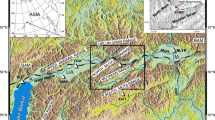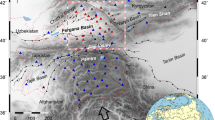Abstract
The regionally extensive Ramu-Markham-Fault-Zone (RMFZ) in Papua-New-Guinea (PNG) passes through the seismically-active hinterland of the Bismarck subduction zone in SW-Pacific. The seismicity map for 400km segment of RMFZ shows that higher magnitude earthquakes mainly originate in four spatial clusters (I–IV), asymmetrically disposed from in-land to offshore on either side of RMFZ. The cluster III have produced the 2019 Buloloearthquake (Mw 7.1). The spatial and temporal characters for all four seismic clusters was estimated by: (i) b-value based on maximum-likelihood method; (ii) expected maximum magnitude (Mw) by Gumbel extreme value statistics and surface rupture length; and (iii) the Hurst coefficient (K) and Hurst plot. Hurst plots on sequential seismic moments in the clusters illustrate an alternating positive and negative sloping moment-release pattern over progressive time-period that corresponds to low and high b-values respectively. The regional stress pattern on north and south of RMFZ and for four seismic clusters are analysed by inversion of CMT focal-mechanism data. The result unravels a significant change in regional stress pattern across the RMFZ: (i) a pure-compressive stress regime corresponding to clusters I and II in the ‘PNG Highlands’ that gradually changes to transpressive in the off-shore cluster IV along north of RMFZ, and (ii) the regional stress pattern for earthquakes south of RMFZ including cluster III shows absence of any particular stress orientation and causative faults are randomly oriented. This leads to the presentation that RMFZ is a deep penetrative fault, rather than a crustal ramp fault restricted to 11–18km depth as advocated in literature.
Similar content being viewed by others
References
Abers, G., and McCaffrey, R. (1988) Active deformation in the New Guinea fold and thrust belt: Seismological evidence for strike slip faulting and basement involved thrusting. Jour. Geophys. Res., v.93, pp.13332–13354.
Aki, K. (1965) Maximum likelihood estimate of b in the formula log N = abM and its confidence limits. Bull. Earthquake Res. Inst., Tokyo Univ., v.43, pp.237–239.
Amorese, D., Grasso, J-R., and Rydelek, P.A., (2010) On varying b-values with depth: results from computer-intensive tests for Southern California. Geophys. Jour. Internat., v.180, pp.347–360.
Anton, L. and Gibson, G., (2007) Earthquake hazard in Papua New Guinea: Problems and the way forward. Monash Univ., Melbourne. https://www.researchgate.net/profile/Gary_Gibson4/publication/237387648_Earthquake_HazardIn_Papua_New_Guinea_Problems_And_The_Way_Forward/links/552bbdbd0cf29b22c9c1e0a0.pdf.
Chan, L.S. and Chandler, A. M. (2001) Spatial bias in b-value of the frequency magnitude relation for the Hong Kong region. Jour. Asian Earth Sci., v.20, pp.3–81.
Delvaux, D. and Sperner, B. (2003) Stress tensor inversion from fault kinematic indicators and focal mechanism data: the TENSOR program. In: Nieuwland D (Ed.), New Insights into Structural Interpretation and Modelling. Geol. Soc. London, Spec. Publ., v.212, pp.75–100.
Gumbel, E.J. (1958) Statistics of Extremes. Columbia Univ. Press, New York, 375p.
Hatzidimitriou, P., Mountrakis, D.P. and Papazachos, B. (1985) The seismic parameter b of the frequency-magnitude relation and its association with the geological zones in the area of Greece. Tectonophysics, v.120, pp.141–151.
Hanks, H.C., and Kanamori, H., (1979) A moment magnitude scale. Jour. Geophys. Res., v.84(B5), pp.2348–2350. DOI: https://doi.org/10.1029/JB084iB05p02348.
Hayes, G. and Crone, T. (2019) At what depth do earthquakes occur? What is the significance of the depth? section in Natural Hazards. Retrieved from United States Geological Survey. https://www.usgs.gov/faqs/what-depth-do-earthquakes-occur-what-significance-depth?qt-news_science_products=0#qt-news_science_products.
Hurst, H.E. (1951) Long term storage capacity of reservoirs. T. Amer. Soc. Civil Eng., v.16, pp.770–808.
Hurst, H.E. (1956) Methods of using long-term storage in reservoirs. Proc. Inst. Civil Eng. Part 1, 5, pp.519–590.
Kanamori, H. (1981) The nature of seismic patterns before large earthquakes. In: Simpson, D.W., and Richards, P.G. (Eds.), Earthquake Prediction: An International Review, Maurice Ewing Series, Vol.4, AGU, Washington D.C., pp.1–19.
Main, I.G., Meredith, P., and Jones, C. (1989) A reinterpretation of the precursory seismic b-value anomaly from fracture mechanics. Geophys. Jour. Internat., v.96, pp.131–138.
Mansukhani, S. (2012) The Hurst Exponent: Predictability of Time Series. Analytics Magazine, Issue July/August 2012, http://analytics-magazine.org/the-hurst-exponent-predictability-of-time-series/
Mcguire, R.K. (2004) Seismic Hazard and Risk Analysis, EERI Monograph 10, Earthquake Engineering Research Institute, Oakland, California, 221p.
Mukhopadhyay, B., Sengupta, D., Mondal, P. K., and Gonnade, G.D. (2016) Seismotectonic appraisal and tsunami potentiality of the seismic source zones in Andaman-Sumatra arc system, Indian Ocean. Indian Jour. Geosci., v.70, pp.139–152.
Schorlemmer, D., Wiemer, S. and Wyss, M. (2005) Variations in earthquake-size distribution across different stress regimes. Nature, v.437, pp.539–542.
Scordilis, E.M. (2006) Empirical global relations converting MS and mb to moment magnitude. Jour. Seismol., v.10, pp.225–236.
Shi, Y. and Bolt, B. A. (1982) The standard error of the magnitude-frequency b-value. Bull. Seismo. Soc. Amer., v.721, pp.1677–1687.
Stevens, C., McCaffrey, R., Silver, E.A., Sombo, Z., English, P., van der Kevie, J. (1998) Mid crustal detachment and ramp faulting in the Markham Valley, Papua New Guinea. Geology, v.26, pp.847–850.
Stanaway, R. (2014) Deformation modelling to support the Papua New Guinean Geodetic Datum 1994 (PNG94). Kuala Lumpur, FIG Congress.
Stanaway, R., Wallace, L., Sombo, Z., Peter, J., Palusi, T., Safomea, B., and Nathan, J., (2009) Lae, a city caught between two plates — 15 years of deformation measurements with GPS. 43rd Association of Surveyors PNG Congress, Lae, 12th—15th August 2009, Focus on Challenges; Society-Space-Surveyors.
Tregoning, P., Lambeck, K., Stoltz, A., Morgan, P., McClusky, S. C., Van der Beek, P., McQueen, H., Jackson, R.J., Little, R.P., Laing, A., and Murphy, B., (1998) Estimation of current plate motions in Papua New Guinea from Global Positioning System observations. Jour. Geophys. Res., v.103, pp.12181–12203.
Tregoning, P., Jackson, R. J., McQueen, H., Lambeck, K., Stevens, C., Little, R. P., Curley, R., and Rosa, R. (1999) Motion of the South Bismarck Plate, Papua New Guinea. Geophys. Res. Lett., v.26, pp.3517–3520.
Tsapanos, T. (1990) b-value of two tectonic parts in the circum-Pacific belt. PAGEOPH, v. 143, pp.229–242.
Urbancic, T.I., Trifu, C.I., Long, J.M., and Young, R.P. (1992) Space-time correlation of b values with stress release. PAGEOPH, v.139, pp.449–462.
Wallace, L. (2002) Tectonics and arc-continent collision in Papua New Guinea: Insights from geodetic, geophysical and geologic data. PhD Thesis, University of California, Santa Cruz, 244p.
Wallace, L.M., Stevens, C., Silver, A., McCaffrey, R., Loratung, W., Hasiata, S., Stanaway, R., Curley, R., Rosa, R., and Taugaloidi, J. (2004) GPS and seismological constraints on active tectonics and arc continent collision in Papua New Guinea: Implications for mechanics of microplate rotations in a plate boundary zone. Journal of Geophysical Research: Solid Earth 109, pp.B5. DOI: https://doi.org/10.1029/2003JB002481
Wallis, J.R., and Matalas, N.C. (1971) Correlogram analysis revisited. Water Resour. Res., v.7, pp. 448–1459. DOI: https://doi.org/10.1029/WR007i006p01448.
Wells, D.L., and Coppersmith, K.J. (1994) New empirical relationships among magnitude, rupture length, rupture width, rupture area and surface displacement. Bull. Seismol. Soc. Amer., v.84(4), pp.974–1002.
Wiemer, S. and Wyss, M. (1997) Mapping the frequency-magnitude distribution with depth in two volcanic areas: Mount St. Helens, Washington, and Mount Spurr, Alaska. Geophy. Res. Lett., v.24, pp.189–192.
Author information
Authors and Affiliations
Corresponding authors
Rights and permissions
About this article
Cite this article
Noho, G., Mukhopadhyay, M., Mukhopadhyay, B. et al. Characteristics of the Seismic Clusters Bounding the Ramu-Markham Fault Zone, Eastern Papua New Guinea. J Geol Soc India 97, 9–20 (2021). https://doi.org/10.1007/s12594-021-1621-6
Received:
Accepted:
Published:
Issue Date:
DOI: https://doi.org/10.1007/s12594-021-1621-6




